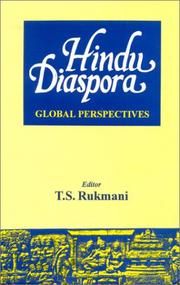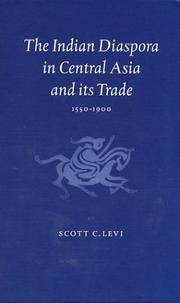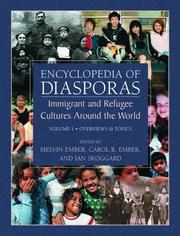| Listing 1 - 10 of 11 | << page >> |
Sort by
|
Book
ISBN: 9780415836036 0415836034 0415836042 9780415836043 Year: 2016 Publisher: New York: Routledge,
Abstract | Keywords | Export | Availability | Bookmark
 Loading...
Loading...Choose an application
- Reference Manager
- EndNote
- RefWorks (Direct export to RefWorks)
Hinduism in the Modern World presents a new and unprecedented attempt to survey the nature, range, and significance of modern and contemporary Hinduism in South Asia and the global diaspora. Organized to reflect the direction of recent scholarly research, this volume breaks with earlier texts on this subject by seeking to overcome a misleading dichotomy between an elite, intellectualist "modern" Hinduism and the rest of what has so often been misleadingly termed "traditional" or "popular" Hinduism. Without neglecting the significance of modern reformist visions of Hinduism, this book reconceptualizes the meaning of "modern Hinduism" both by expanding its content and by situating its expression within a larger framework of history, ethnography, and contemporary critical theory. This volume equips undergraduate readers with the tools necessary to appreciate the richness and diversity of Hinduism as it has developed during the past two centuries.
Hinduism. --- Hinduism --- Hindu diaspora.

ISBN: 8121510392 Year: 2001 Publisher: New Delhi : Munshiram Manoharlal,
Abstract | Keywords | Export | Availability | Bookmark
 Loading...
Loading...Choose an application
- Reference Manager
- EndNote
- RefWorks (Direct export to RefWorks)
Hindu diaspora --- Hinduism --- Hindus
Book
ISBN: 8120831977 Year: 2007 Publisher: Delhi Motilal Banarsidass
Abstract | Keywords | Export | Availability | Bookmark
 Loading...
Loading...Choose an application
- Reference Manager
- EndNote
- RefWorks (Direct export to RefWorks)
Book
ISBN: 9780826430656 Year: 2010 Publisher: London Continuum International Publishing Group
Abstract | Keywords | Export | Availability | Bookmark
 Loading...
Loading...Choose an application
- Reference Manager
- EndNote
- RefWorks (Direct export to RefWorks)
Hinduism --- India --- Hindu Dharma --- caste --- gender --- political Hinduism --- Hindu diaspora
Book
ISBN: 1845532341 9781845532345 Year: 2007 Publisher: London Equinox
Abstract | Keywords | Export | Availability | Bookmark
 Loading...
Loading...Choose an application
- Reference Manager
- EndNote
- RefWorks (Direct export to RefWorks)
"Saivism in the Diaspora explores contemporary manifestations of the worship of Siva that have transmigrated to the West. It looks at Hindu vernacular traditions or "village Hinduism" especially in the context of the Hindu diaspora, where the general assumption is that such forms of Hinduism cannot survive as they lack the infrastructure and the rural environment. Based on extensive fieldwork in Britain and India, the author shows that significant developments are taking place where Hindu communities have achieved sufficient concentration for various movements to appear that reproduce "folk traditions" connected to a particular locale in the subcontinent. These movements often display a focus on the pragmatic or apotropaic motivation for the worship of deities associated with healing. The focus is on the Baba Balaknath communities originating in the Punjab and Himachal Pradesh; the worship of Murugan amongst Tamil populations and the Community of the Many Names of God in Wales which originated in the worship of Subramaniyam in Sri Lanka." "Saivism in the Diaspora not only throws some clarity on changing beliefs and practices in the Hindu diaspora, particularly the role of the apotropaic or pragmatic dimension, but it also helps to understand important theoretical concepts such as Sanskritization and the relationship between the "Little Tradition" and the "Great Tradition" or All-India and local traditions."--Jacket.
Hindu diaspora --- Hinduism --- Kārttikeya (Hindu deity) --- Śaiva Siddhānta --- Śaivism --- Rituals --- Cult
Multi
ISBN: 9780387299044 0387299041 Year: 2005 Publisher: New York, N.Y. : Springer,
Abstract | Keywords | Export | Availability | Bookmark
 Loading...
Loading...Choose an application
- Reference Manager
- EndNote
- RefWorks (Direct export to RefWorks)
Immigration is a topic that is as important among anthropologists as it is the general public. Almost every culture has experienced adaptation and assimilation when immigrating to a new country and culture; usually leaving for what is perceived as a "better life". Not only does this diaspora change the country of adoption, but also the country of origin. Many large nations in the world have absorbed, and continue to absorb, large numbers of immigrants. The foreseeable future will see a continuation of large-scale immigration, as many countries experience civil war and secessionist pressures. Currently, there is no reference work that describes the impact upon the immigrants and the immigrant societies relevant to the world's cultures and provides an overview of important topics in the world's diasporas. The encyclopedia consists of two volumes covering three main sections: Diaspora Overviews covers over 20 ethnic groups that have experienced voluntary or forced immigration. These essays discuss the history behind the social, economic, and political reasons for leaving the original countries, and the cultures in the new places; Topics discusses the impact and assimilation that the immigrant cultures experience in their adopted cultures, including the arts they bring, the struggles they face, and some of the cities that are in the forefront of receiving immigrant cultures; Diaspora Communities include over 60 portraits of specific diaspora communities. Each portrait follows a standard outline to facilitate comparisons. The Encyclopedia of Diasporas can be used both to gain a general understanding of immigration and immigrants, and to find out about particular cultures, topics and communities. It will prove of great value to researchers and students, curriculum developers, teachers, and government officials. It brings together the disciplines of anthropology, social studies, political studies, international studies, and immigrant and immigration studies.
Social sciences (general) --- Ethnology. Cultural anthropology --- vluchtelingen --- diaspora --- sociale wetenschappen --- methodologieën --- Emigration and immigration --- Immigrants --- Refugees --- African diaspora. --- Asian diaspora. --- Hindu diaspora. --- Sikh diaspora. --- Jewish diaspora. --- Kurdish diaspora. --- Muslim diaspora. --- South Asian diaspora. --- Social aspects

ISBN: 1576079058 Year: 2004 Publisher: Santa Barbara, California ABC-Clio, Inc.
Abstract | Keywords | Export | Availability | Bookmark
 Loading...
Loading...Choose an application
- Reference Manager
- EndNote
- RefWorks (Direct export to RefWorks)
Hinduism --- ritual --- culture --- practices --- oral tradition --- written tradition --- Hindu devotion --- the Hindu ritual calendar --- Hindu ethics --- Hindu thought --- Gurus --- caste --- India --- social values --- fundamentalism --- secularism --- the environment --- the Hindu diaspora

ISBN: 9004123202 9786610466450 1417502282 1280466456 9047401204 9781417502288 9789047401209 9789004123205 6610466459 9781280466458 Year: 2002 Publisher: Leiden Boston Brill
Abstract | Keywords | Export | Availability | Bookmark
 Loading...
Loading...Choose an application
- Reference Manager
- EndNote
- RefWorks (Direct export to RefWorks)
This text is concerned with the concept of time in the Bible and in later literature, primarily that of the Judaean Desert sect. The work discusses issues of terminology, substance and ideology that arise from the totality of texts dealing with the subject of time.
East Indians. --- Hindu diaspora. --- India - Commerce - Asia, Central - History. --- Merchants, Foreign. --- Local Commerce --- Commerce --- Business & Economics --- Hindu diaspora --- East Indians --- Merchants, Foreign --- History. --- India --- Asia, Central --- Asian Indians --- Indians, East --- Indic peoples --- Foreign merchants --- Diaspora, Hindu --- Hindus --- Diaspora --- Central Asia --- Soviet Central Asia --- Tūrān --- Turkestan --- West Turkestan --- Indland --- Ḣindiston Respublikasi --- Republic of India --- Bhārata --- Indii︠a︡ --- Inde --- Indië --- Indien --- Sāthāranarat ʻIndīa --- Yin-tu --- Bharat --- Government of India --- Ethnology --- East Indian diaspora --- Human geography --- Migrations --- Asia --- インド --- Indo --- هند --- Индия --- Indians (India)

ISBN: 0306483211 9780306483219 0387299041 0387335935 Year: 2005
Abstract | Keywords | Export | Availability | Bookmark
 Loading...
Loading...Choose an application
- Reference Manager
- EndNote
- RefWorks (Direct export to RefWorks)
Immigration is a topic that is as important among anthropologists as it is the general public. Almost every culture has experienced adaptation and assimilation when immigrating to a new country and culture; usually leaving for what is perceived as a "better life". Not only does this diaspora change the country of adoption, but also the country of origin. Many large nations in the world have absorbed, and continue to absorb, large numbers of immigrants. The foreseeable future will see a continuation of large-scale immigration, as many countries experience civil war and secessionist pressures. Currently, there is no reference work that describes the impact upon the immigrants and the immigrant societies relevant to the world's cultures and provides an overview of important topics in the world's diasporas. The encyclopedia consists of two volumes covering three main sections: Diaspora Overviews covers over 20 ethnic groups that have experienced voluntary or forced immigration. These essays discuss the history behind the social, economic, and political reasons for leaving the original countries, and the cultures in the new places; Topics discusses the impact and assimilation that the immigrant cultures experience in their adopted cultures, including the arts they bring, the struggles they face, and some of the cities that are in the forefront of receiving immigrant cultures; Diaspora Communities include over 60 portraits of specific diaspora communities. Each portrait follows a standard outline to facilitate comparisons. The Encyclopedia of Diasporas can be used both to gain a general understanding of immigration and immigrants, and to find out about particular cultures, topics and communities. It will prove of great value to researchers and students, curriculum developers, teachers, and government officials. It brings together the disciplines of anthropology, social studies, political studies, international studies, and immigrant and immigration studies.
Assimilatie (Sociologie) --- Assimilation (Sociologie) --- Assimilation (Sociology) --- Immigrants --- History --- Encyclopedias --- Histoire --- Encyclopédies --- Emigration and immigration --- Refugees --- Immigration & Emigration --- Social Change --- Sociology & Social History --- Political Science --- Social Sciences --- Law, Politics & Government --- Social aspects --- Encyclopédies --- EPUB-LIV-FT LIVSOCIA SPRINGER-B --- Displaced persons --- Emigrants --- Foreign-born population --- Foreign population --- Foreigners --- Migrants --- Immigration --- International migration --- Migration, International --- Social sciences. --- Anthropology. --- Social Sciences. --- Methodology of the Social Sciences. --- Population geography --- Colonization --- Persons --- Aliens --- Deportees --- Exiles --- Social sciences --- Methodology. --- Human beings --- Behavioral sciences --- Human sciences --- Sciences, Social --- Social science --- Social studies --- Civilization --- Encyclopedias. --- Primitive societies --- Sociology --- Sociological Methods. --- African diaspora. --- Asian diaspora. --- Hindu diaspora. --- Sikh diaspora. --- Jewish diaspora. --- Kurdish diaspora. --- Muslim diaspora. --- South Asian diaspora.

ISBN: 0520939964 9786612358586 1282358588 143370000X 9780520939967 9780520248809 0520248805 9781433700002 9780520248793 0520248791 6612358580 9781282358584 Year: 2006 Publisher: University of California Press Berkeley
Abstract | Keywords | Export | Availability | Bookmark
 Loading...
Loading...Choose an application
- Reference Manager
- EndNote
- RefWorks (Direct export to RefWorks)
Little India is a rich historical and ethnographic examination of a fascinating example of linguistic plurality on the island of Mauritius, where more than two-thirds of the population is of Indian ancestry. Patrick Eisenlohr's groundbreaking study focuses on the formation of diaspora as mediated through the cultural phenomenon of Indian ancestral languages-principally Hindi, which is used primarily in religious contexts. Eisenlohr emphasizes the variety of cultural practices that construct and transform boundaries in communities in diaspora and illustrates different modes of experiencing the temporal relationships between diaspora and homeland.
Hindus --- Anthropological linguistics --- Hindoos --- Religious adherents --- Anthropo-linguistics --- Ethnolinguistics --- Language and ethnicity --- Linguistic anthropology --- Linguistics and anthropology --- Anthropology --- Language and culture --- Linguistics --- Diaspora, Hindu --- East Indian diaspora --- Human geography --- Diaspora. --- Ethnic identity. --- Diaspora --- Migrations --- Mauritius --- Île Maurice --- Maurice --- Drontens ö --- Mōrishasu --- Mavrikiĭ --- Republic of Mauritius --- Môriśasa --- Mārīśasa --- Mauritious --- République de Maurice --- Repiblik Moris --- モーリシャス --- Mauricio --- Estado de Mauricio --- מאוריציוס --- Maʼuritsyus --- Île de France --- Ethnic relations. --- Anthropological linguistics. --- Anthropological linguistics - Mauritius. --- Hindu diaspora. --- Hindus. --- Indian religions --- Ethnology. Cultural anthropology --- Indic languages --- ancestral languages. --- anthropology. --- cultural practices. --- diaspora communities. --- diaspora. --- ethnographers. --- ethnography. --- ethnolinguistics. --- ethnolinguists. --- generational. --- hindi. --- hindusim. --- historians. --- historical perspective. --- homeland. --- india. --- indian ancestry. --- language and culture. --- linguistic connection. --- linguistics. --- linguists. --- lingustic plurality. --- mauritius. --- nonfiction. --- politics. --- religious language use. --- religious practices. --- shared language.
| Listing 1 - 10 of 11 | << page >> |
Sort by
|

 Search
Search Feedback
Feedback About UniCat
About UniCat  Help
Help News
News